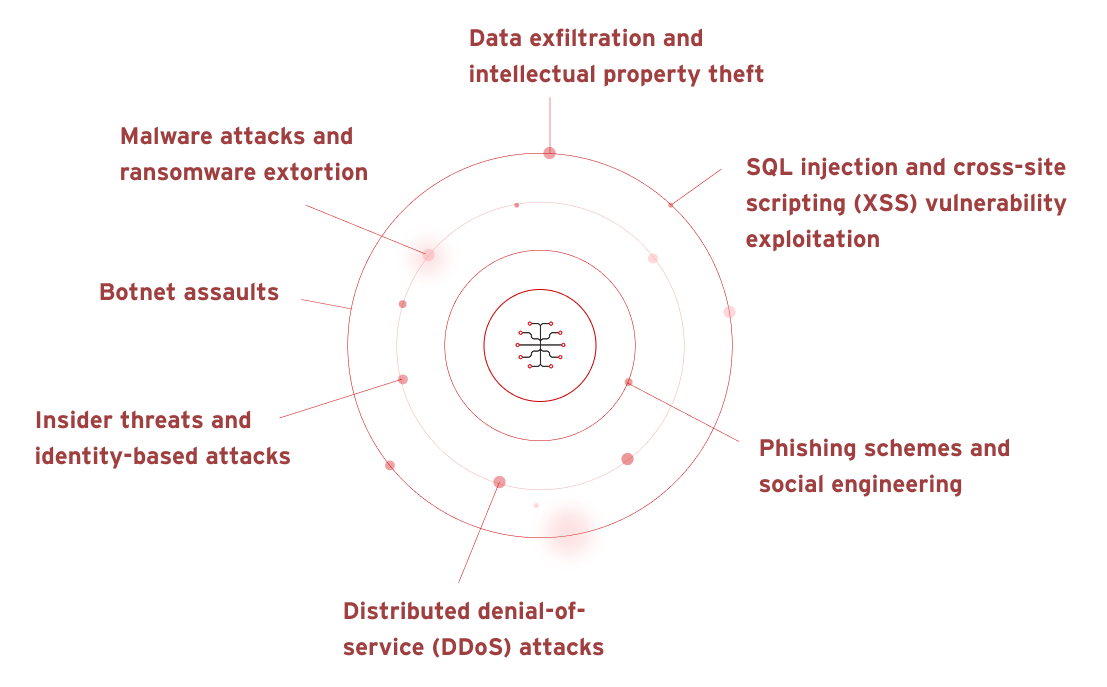Proactive security is a preemptive approach to cybersecurity that prioritizes identifying, anticipating, and preventing cyberattacks before they occur.
Table of Contents
Cybersecurity threats have become increasingly sophisticated, fast-moving, and costly. While reactive security remains a key part of an organization’s security posture, it’s no longer sufficient to protect organizations from the financial, operational, and reputational damage of cyberattacks alone. As a result, there’s a growing need for organizations to adopt a much more proactive approach to cybersecurity.
Proactive security represents a fundamental shift from response-based to prevention-focused cybersecurity. Rather than waiting for incidents to occur, this approach prioritizes identifying, anticipating, and preventing cyberattacks before they can infiltrate organizational systems.
Proactive vs. reactive security
Reactive security focuses on an organization's ability to respond quickly and effectively after security breaches have already occurred. This approach typically involves incident response teams following established cybersecurity playbooks, disaster recovery plans, and technologies such as security information and event management (SIEM), endpoint detection and response (EDR), extended detection and response (XDR), and log management systems
Proactive security emphasizes prediction, prevention, and preparedness, encompassing several key strategies:
- Exposure management involves discovering, assessing, and mitigating potential security vulnerabilities, system misconfigurations, and risks associated with an organization's digital assets.
- Penetration testing employs security practitioners who manually probe the organization's IT landscape to identify security gaps before malicious actors can exploit them.
- Vigilant patching ensures continuous software updates and security patches are applied promptly to remediate known vulnerabilities.
- Security awareness training provides ongoing education to equip employees with essential knowledge for identifying security threats, protecting sensitive information, and following cybersecurity best practices.
- Threat intelligence focuses on identifying the latest, most likely, and most dangerous threats, vulnerabilities, attack vectors, and indicators of compromise (IOCs), along with effective countermeasures.
Reactive Cybersecurity
Proactive Cybersecurity
Occurs after an incident
Occurs before an incident
Focuses on response and recovery
Focuses on prevention and preparedness
Expensive and time-consuming damage mitigation
Minimizes breach risk and associated costs
Why is proactive security important?
Cyberattacks and cybersecurity breaches cost businesses billions of dollars a year in remediation and recovery expenses—not to mention countless hours in lost productivity.
Beyond financial impact, breaches can compromise an organization’s sensitive or proprietary information, endanger clients and partners, and compromise reputations that organizations have spent years building—virtually overnight.
With so much at stake, and with cybercriminals changing or improving their methods of attack on a daily basis, proactive security has become an essential way for organizations to protect their most valued assets from a wide range of potential threats, including:
- Data exfiltration and intellectual property theft
- Malware attacks and ransomware extortion
- Phishing schemes and social engineering
- Insider threats and identity-based attacks
- Botnet assaults
- SQL injection and cross-site scripting (XSS) vulnerability exploitation
- Distributed denial-of-service (DDoS) attacks
By addressing security vulnerabilities and system misconfigurations early, proactive security measures can dramatically improve an organization’s security posture. They also enhance the organization’s ability to manage and mitigate risks more quickly, efficiently, and cost-effectively.

What are the benefits of proactive security?
Organizations that successfully implement proactive cybersecurity strategies can experience significant advantages:
- Enhanced risk management capabilities enable organizations to identify and address potential threats before they become into costly incidents.
- Future-focused protection helps organizations stay ahead of the latest evolving and emerging cyber threats
- Comprehensive security posture provides more integrated and insight-driven security operations for simplicity across the organization.
- Regulatory compliance ensures adherence to applicable cybersecurity laws, policies, and regulations, reducing legal and financial risks.
- Long-term cost efficiency significantly reduces expenses related to cyberattack remediation, mitigation, and damage control compared to reactive approaches.
What are the challenges and considerations involved in proactive security?
When adopting a proactive approach to cybersecurity, organizations must navigate several important considerations:
- Resource balance represents perhaps the greatest challenge. Organizations must carefully allocate resources, investments, and priorities between proactive and reactive security measures. While proactive security may prevent many attacks, robust reactive capabilities remain essential for addressing any threats that penetrate defenses.
- Future-proofing requirements demand that organizations anticipate cybersecurity trends and adapt their security measures to stay ahead of malicious actors. This requires current threat intelligence, comprehensive threat management strategies, and advanced threat detection and response technologies, including developments in artificial intelligence (AI), machine learning (ML), and agentic AI.
- Continuous assessment is essential, as organizations must regularly evaluate and update their proactive security systems to maintain protection as cybercriminals develop new attack methods and new threats emerge.
Strategies for implementing proactive security
Adopting a proactive security strategy requires a systematic, step-by-step approach.
A comprehensive risk assessment
Serves as the foundation, requiring organizations to identify physical and data assets, analyze potential risks to each, and prioritize protection strategies based on criticality and vulnerability.
Integrated security deployment
Involves not only implementing and continuously updating proactive security measures such as risk-based vulnerability management, but also integrating these capabilities with the organizations existing cybersecurity platform.
Policy development and communication
Requires establishing clear cybersecurity policies and procedures that detail information protection protocols, guide employee behavior, and outline incident response responsibilities. These policies must be communicated enterprise-wide to all security staff and employees.
Continuous training and updates
Ensure that both new and existing employees receive ongoing education about cybersecurity changes, while security software patches and updates are installed promptly to maintain current protection layers.
AI-enhanced capabilities
Leverage the latest advances in AI cybersecurity to help organizations continuously identify risk reduction opportunities and prevent cyberattacks from infiltrating company systems—improving overall security posture through tools for attack surface management, vulnerability management, and security posture management.

Where can I get help with proactive security?
Today’s threat landscape requires a risk-informed model to stay ahead of threats, which means evolving your security strategies from reactive to proactive. Trend Vision One™ is here to help, with the only AI-powered enterprise cybersecurity platform that centralizes cyber risk exposure management, security operations, and robust layered protection.
Natively embedded in the platform, Trend Vision One offers the industry's first proactive cybersecurity AI: Trend Cybertron. With a culmination of our 20-year journey in AI security development, its sophisticated framework of LLM models, datasets, and AI agents analyzes telemetry from native sensors and third-party sources to predict threats and deliver customer-specific recommendations.
All of this combined empowers organizations to eliminate blind spots, prioritize effectively, and position security as a driver of innovation.

Scott Sargeant
Vice President of Product Management

Scott Sargeant, Vice President of Product Management, is a seasoned technology leader with over 25 years of experience in delivering enterprise-class solutions across the cybersecurity and IT landscape.
Frequently Asked Questions (FAQ's)
What is a proactive approach to security?
A proactive security approach focuses on hardening the digital estate to prevent cyberattacks and data breaches from happening, instead of responding after an incident occur.
What is a proactive security mindset?
A proactive security mindset prioritizes identifying system vulnerabilities, misconfigurations, and compromised identities to stop cybersecurity threats from occurring and tends to focus on mitigating risk.
What is proactive security service?
Proactive security services aim to identify, assess, and address potential weaknesses, provide cybersecurity awareness training, and simulate attacks to find vulnerabilities before malicious actors do.
What is proactive cybersecurity?
Proactive cybersecurity is a strategy that focuses on preventing cyberattacks such as the exploitation of vulnerabilities and exfiltration of sensitive or protected data.
What is proactive surveillance?
Proactive surveillance is a preventative approach that aims to predict, identify, and prevent cyber threats before they happen.
What is an example of a proactive security mindset?
A proactive security mindset prioritizes preventative measures, such as proactively finding and remediating security vulnerabilities and misconfigurations or conducting penetration testing to identify system weaknesses.
What is a security-first mindset?
A security-first mindset makes security considerations a priority in every aspect of an organization’s business processes, practices, and operations.
What are the four components of the proactive security paradigm?
Common components of successful proactive security strategies: access to excellent threat intelligences, holistic visibility, continuous monitoring, ongoing assessments, robust stress testing, and strong protection measures.
What is the difference between reactive and proactive security?
Reactive security is about responding to cyberattacks after they happen. Proactive security helps prevent attacks before they occur.
What is the difference between proactive and reactive compliance?
Proactive compliance includes policies and practices that help prevent security issues from happening. Reactive compliance is responding to regulatory violations after a security incident occurs.
